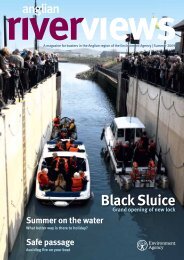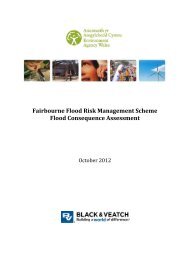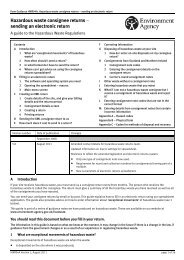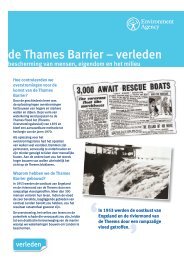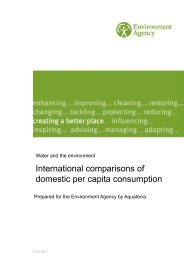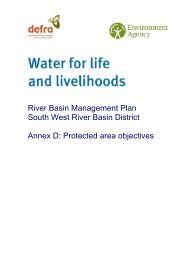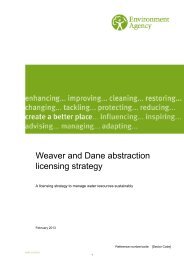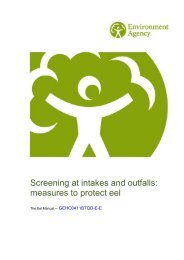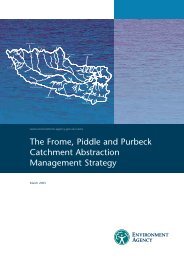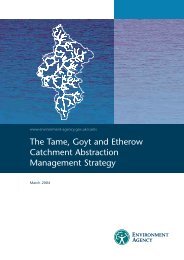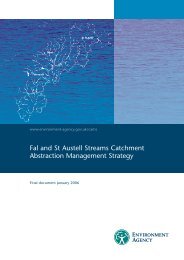preliminary flood risk assessment drain london
preliminary flood risk assessment drain london
preliminary flood risk assessment drain london
You also want an ePaper? Increase the reach of your titles
YUMPU automatically turns print PDFs into web optimized ePapers that Google loves.
1 Introduction<br />
1.1 What is a Preliminary Flood Risk Assessment?<br />
The Preliminary Flood Risk Assessment (PFRA) is a high level screening exercise that brings<br />
together information from a number of sources to assess local <strong>flood</strong> <strong>risk</strong>. The key stages of<br />
PFRA involve:<br />
� Collecting information on past (historic) and future (potential) <strong>flood</strong>s and <strong>flood</strong> <strong>risk</strong>.<br />
� Assembling the information into a Preliminary Assessment Report(PAR).<br />
� Identification of Flood Risk Areas by reviewing the national indicative areas produced<br />
by the Environment Agency alongside local information from the Preliminary<br />
Assessment Report.<br />
This PAR is a key document informing the preparation of future Local Flood Risk Management<br />
Strategies as required by the Flood and Water Management Act 2010 (FWMA) iv . This PAR<br />
identifies key <strong>flood</strong> <strong>risk</strong> areas within the London Borough of Brent (LBB). This document fulfils<br />
the LBB’s obligations as the Lead Local Flood Authority (LLFA) under the requirements of the<br />
Flood Risk Regulations 2009 (FRR) v .<br />
1.2 Background<br />
The FRR came into force in December 2009 with the aim of implementing the requirements of<br />
the European Floods Directive vi in England and Wales. The aim of the Directive is to provide a<br />
consistent approach to managing <strong>flood</strong> <strong>risk</strong> across Europe. It establishes four stages of activity<br />
within a six year <strong>flood</strong> management cycle (Table 1-1).<br />
Stages Delivery Date<br />
Preliminary Assessment Report (PFRA) By December 2011<br />
Develop Flood Risk Areas based on the PFRA findings By December 2011<br />
Derive Flood Hazard and Risk Mapping for each Flood Risk Area By December 2013<br />
Develop an effective Flood Risk Management Plan for each Flood Risk Area By December 2015<br />
Table 1-1 Summary of stages of activity required as part of the European Floods Directive<br />
This PFRA has been undertaken on behalf of Brent, by Hyder and AECOM as part of the Drain<br />
London programme.<br />
The FRRs define new responsibilities for <strong>flood</strong> <strong>risk</strong> management based on the<br />
recommendations of the Pitt Review vii and are included within the FWMA. Under these<br />
legislative items, all Upper Tier Authorities (including the London Boroughs) are designated a<br />
LLFA. As such, LBB has been allocated a number of key responsibilities with respect to local<br />
<strong>flood</strong> <strong>risk</strong> management. A fuller description of these responsibilities is given in Chapter 2.<br />
The scope of the PFRA is to consider past <strong>flood</strong>ing and possible future <strong>flood</strong>ing from surface<br />
water runoff, groundwater and ordinary watercourses in LBB.<br />
The PFRA must consider <strong>flood</strong>s which have SIGNIFICANT harmful consequences for human<br />
health, economic activity and the environment. The work will also assess the existing Indicative<br />
Flood Risk Areas as designated by the EA and determine if any amendments should be made<br />
to this dataset.<br />
UA002334 - Drain London— London Borough of Brent PFRA<br />
Hyder Consulting (UK) Limited-2212959 Page 1<br />
o:\frr review monitoring & reporting team\publishing\unknown\brent\brent_par.docx



